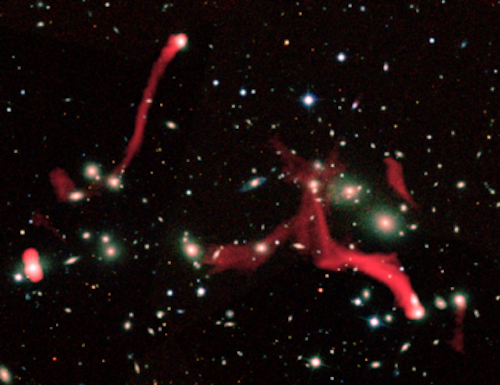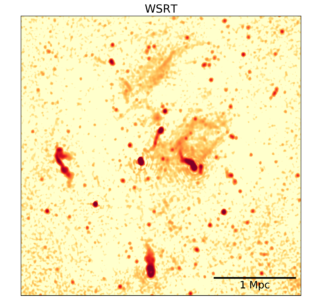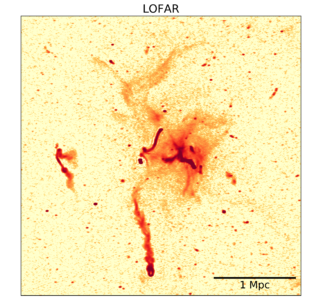6.07.2020
The beautiful mess in Abell 2255
An international team of astrophysicists led by Andrea Botteon from Leiden University, the Netherlands, has shed light on one of the most intricate objects of the radio sky: the galaxy cluster Abell 2255. Thanks to the incredible detailed images obtained with the European radio telescope LOFAR, the scientists have been able to observe details never seen before of the emission from the cluster. The halo in Abell 2255 is not smooth, but contains numerous filaments that have not been seen previously. The result has been presented today at the virtual annual meeting of the European Astronomical Society (EAS) and will be published in The Astrophysical Journal.
The observations carried out with the LOFAR radio telescope are changing the picture that astrophysicists had on galaxy clusters. Despite their name, clusters are not only composed by hundreds of galaxies spread over millions of light years that are bound together by gravity, but also contain particles moving at speeds close to the speed of light that are able to emit radiation in the radio band, when they interact with the cluster magnetic field. These radio emissions, that extend from cluster centers for millions of light years and are produced when two clusters of galaxies collide, have been called radio halos due to their generally spherical and smooth appearance.
The halo in Abell 2255 appears to be anything but smooth, though. First author Botteon: “We discovered the existence of numerous filaments within the halo emission that have not been seen previously. This was possible thanks to LOFAR, which has a sensitivity and angular resolution much higher than the radio telescopes that have observed galaxy clusters in the past, and also because the discovered filaments emit most of their radiation in long radio wavelengths, precisely those detected by the LOFAR antennas.”

The filamentary structures observed by LOFAR at the center of Abell 2255, here reported in red. These radio emissions are due to trails of particles and magnetic fields released by the galaxies during their motion inside the cluster (credits: Botteon et al. (2020) – LOFAR – SDSS).
Radio halos are still enigmatic sources for astrophysicists. One of the most accepted hypotheses on their origin is that they form due to the turbulent motions generated in the cluster gas, triggered when two clusters collide. In this framework, the new observations could provide valuable insights on radio halos.
“The filaments discovered by LOFAR could form exactly as a consequence of these turbulent motions,” says Gianfranco Brunetti of INAF-Bologna (Italy) and second author of the study. “Another possibility that we are considering is that the filaments originate from the interaction between the galaxies, which move at speeds of many hundreds of km/s inside the cluster and the plasma that produces the radio emission of the halo.”
“The filamentary nature of the emission shows the importance of turbulent magnetic fields, as the bands of emission are likely to follow the threads of magnetic fields,” adds team member Marcus Brüggen from the University of Hamburg, Germany.


But there is much more in the LOFAR images of Abell 2255, where radio signals coming from regions very distant from the cluster center are also observed. Astrophysicists believe that these emissions trace shock waves that propagate outwards at great distances and are able to accelerate energetic particles and amplify magnetic fields. In this peripheral environment the emission from the hot intergalactic gas is extremely weak, at the limits of the capabilities of the current instruments that observe in the X-rays and of the Planck satellite. Therefore, radio observations give the unique opportunity to reveal the motions of matter in unexplored cluster regions.
“In order to study how far the radio emission extends in the cluster, in the past few months LOFAR has carried out an even deeper observation of Abell 2255,” says co-author Reinout van Weeren from Leiden University, the Netherlands. “One of the goals is to understand if the radio emission extends also beyond Abell 2255, tracing the gigantic cosmic web that connects clusters of galaxies in the Universe.”
Quelle: European Astronomical Society (EAS)
